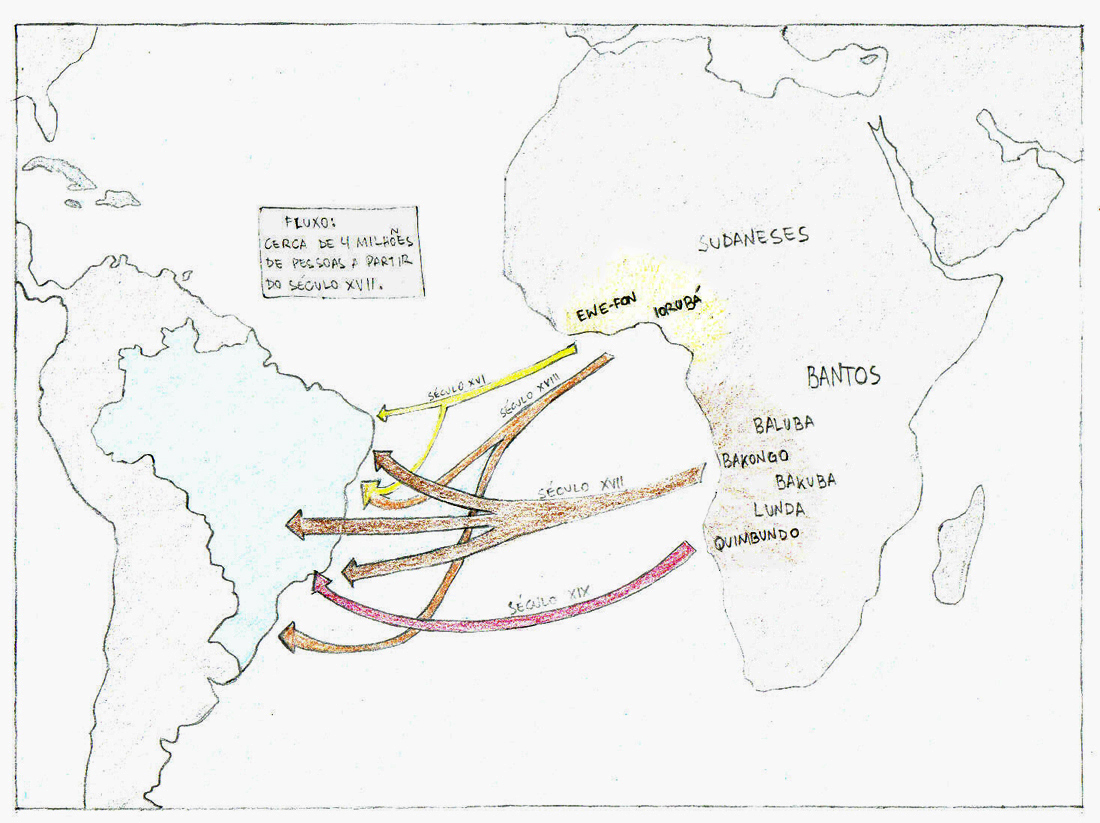- Opening remarks:
- This is a multimedia item. Several phonograms were associated with the text as sound illustrations.
- To listen to them, just click on the words designated with links.
- Translation from Brazilian Portuguese to english: GARinchA & Dr.Sócrates
▶You can find the original article in Portuguese language here◀
As it is well known, the Brazilian Music plurality is, to a great extent, the result of the encounter between people of different origins, between the social strata or classes in which they were situated, which went on over the last five centuries of history of our ‘young’ country; encounters which took place at different times, in situations ranging from confrontation to rapprochement, creating a range of ways from which stand out elements of resistance on the side of the ethnic-cultural or social original matrices, or they crystallize as more or less complex hybridizations. Concurrent to this historical and social scenario there is another one, not less important for the formation of Brazilian musicality, namely geography. The vast proportions of the land, with contrasting landscapes – natural, human, economic – contributed strongly to the formation of regionalized genres and styles, subdivided in a profusion of accents.
We have already pointed out in earlier writings those aspects of unity that underlie the diversity of the traditional popular music of Brazil, its recurring themes and the socio-historical processes that created them [1]. Here, we are interested in addressing briefly some aspects regarding the formation of people’s traditional music in relation to the displacement of African populations toward and within Brazil; how these human flows left over and over their cultural mark along the way, shaping new cartographies that challenge the boundaries of political geography; how the musical background of these travellers from different black diasporas that have driven our epic demographics are related to the music of their places of destination. My own geographical limits at the place of destination are the Northeast and Southeast regions of Brazil. The places of my origin are South Central and West Africa.
The first diaspora that can be characterized as such is the one of enslaved Africans brought to Brazil [2]. From the 17th century on the model for the establishment of colonies in the New World using the manpower of the African slave turns dominant, substantially linked to the economic strength of the transatlantic slave venture. About four million people were in the course of four centuries expatriated to Brazil, mainly belonging to two major ethnic-linguistic groups: the Bantu, belonging to various ethnic groups in South Central Africa, especially from those areas that today form Angola, Congo and Mozambique; and the Sudanese from West Africa, mainly from the region of today Nigeria and Benin, here called Jêje-nagôs. The concentration of enslaved Africans in the economically most productive areas of Brazil took place differently for the Bantu and Sudanese, temporally and spatially, following the whim of alliances between traffickers and local leaders, the price associated with the ethnic origin of the enslaved individual, the demand for certain skills that were assigned to them (skilled labour power), among other factors. So we have in the 17th century until the second half of the 18th century a continuous flow of Bantus, even more vigorously in the 19th century, practically almost until abolition. The Sudanese, which were deported to Brazil in small numbers already in the 16th century, come in larger scale in the second half of the 18th century [3].
Although the relative number of Bantu and Sudanese that were abducted to Brazil by the slave traffickers is currently under revision, we know thanks to the use of modern analysis of mitochondrial DNA sampling made in different regions of Brazil that the number of Bantus far outweighs the Sudanese. In general terms, their geographical distribution goes as follows: the Bantus were first brought to the sugar production in the Northeast region, from the 18th century part of them are moved by internal trafficking to the mining regions of Minas Gerais and Goiás, while Atlantic trafficking still continues. In the 19th century Bantus work massively in the valeparaibana coffee plantations of Rio, São Paulo and south of Minas Gerais, and later in the second half of the century they are moved to the west of São Paulo, together with new imports and, to this time, with the first waves of European immigrants.
The Bantu musical presence is reported by chroniclers and travellers from the 17th century, when describing mainly two types of events with music and dance: one of a more secluded, intra-Community character done at night in the yards of the farms or in the slave quarters during days of rest, which were called “batuques” (drums); another one, a public event, where the Bantus of black Catholic brotherhoods came out in procession during religious or official celebrations following their Congo Kings and praising Nossa Senhora do Rosário, known as “congadas”. Batuques (drums) and congadas represent two extremes for the slave colonial mentality, designated respectively as “dishonest” and “honest” pastime of the blacks. The batuques were seen as offensive to morality, religion and especially dangerous to public safety because congregated large numbers of blacks on the farms, which frightened the white minority. These celebrations established themselves as important areas of resistance for the communities of Afro-descendants, where the successive attempts by the colonizers to forbid them were in vain. Whereas the congadas, which opened to the black the possibility of having some inclusion and social visibility through the Brotherhoods’ parades on festive occasions, were seen by slave owners as a beneficial activity for the Christianization of their captives and as deterrence from rebellious initiatives. However, the congadas, although supported by a religious institution of European type – the Lay Brotherhoods -, incorporated African ritual forms into a Catholic celebration, like the worshipping of the forebears, honouring their noble lineages in the figure of the Kings of Congo.
With respect to the Sudanese – being considered in the context of slavery as belonging to one of the most advanced and refined cultures – traffickers took them especially to the cities of the Northeast at the time of growing demand for specialized urban services, such as domestic, trade and the handicrafts. In small numbers they also settle in some cities gaúchas where fortune was made with the production of jerky.
Many of the slaves in urban areas were permitted to move around and therefore they could organize themselves in groups according to ethnic and cultural affinities. It is in this context that in cities like Salvador, Recife, São Luís do Maranhão and Porto Alegre the first organized communities of worship to African deities arise. Sudanese Jêjes (Ewe-Fon) and Nagôs (Yoruba), being culturally dominant in these areas, establish a model of worship that is adopted by other African ethnic groups present there, each one incorporating their tutelary deities to the pantheons that were being created [4]. These religious communities were structured according to the ethnic origin of their members, worshiping pantheons made of Orishas (Yoruba), Voduns (Ewe-Fon) or Nkisis (Congo basin), which became known as candomblés of the Ketu and Angola (Bahia) branches (nations), xangôs (Pernambuco), tambores-de-mina (Maranhão), batuques (Rio Grande do Sul). The candomblés, which were confused by the early chroniclers with the batuques of the Bantu, were also subject of police harassment, as “treacherous”, at least until the first half of the 20th century.
Broadly speaking, we can summarize the course of the musicality of the two main ethnic groups of the African Diaspora in Brazil as following: the Sudanese Jêje-nagôs of West Africa mainly settled in urban areas of the Northeast, where they left their cultural mark almost exclusively in the field of Afro-Brazilian religion (candomblés); while the Bantus of South Central Africa, mostly settled in rural areas, with the highest density in the Northeast and especially in Southeastern Brazil, strongly permeated with their music a variety of popular festivities, either of the Afro-Brazilian religion, of popular Catholicism or profane celebrations in cities or in the countryside, besides popular urban music. The Bantu musical presence goes therefore beyond the limits of the Afro-Brazilian religion; although we must remember that even in those apparently “profane” demonstrations lies beneath a deep spirituality, revealing an African worldview in Brazil (as it happens in the candomblés): for example, reverence for ancestral spirituality, the sacredness of the drums and the power attributed to speech to awaken vital forces. In traditional popular music the sphere of influence of the Bantu musicality basically covers the two major groups already referred to: the congadas – maracatus, congos, congadas, moçambiques, ticumbis, catumbis, taieiras, cambindas, catopês, marujos, etc., with greater presence in the state of Minas Gerais, where the Black Brotherhoods had and still have an essential role in the religious life of African descendants – and the batuques – jongo, batuque de umbigada, candombe, sussa, zambê, tambor de criola, carimbó, etc. -. In the field of organology, the Bantu presence manifests itself in a set of hand drums with a single skin affixed by nails and tuned by fire (batuques) or the drums tuned by ropes and wedges (candomblés of the Angola branch), the friction drums (cuícas), musical bows (berimbaus), the morphological and timbre reinterpretation of European portable drums played with sticks (caixas de congada, alfaias de maracatus), etc. In the rhythmic patterns of 8 or 16 basic pulse dominate [5], as well as the strong syncopation [6] and polyrhythm [7] and, considering the melodic systems, the heptatonic scale (seven notes scale) prevails. To note also the polyphonic choir practice (many-voiced) in many manifestations of Bantu descent, contradicting the widespread belief that the only African contribution to Brazilian music consisted in the drums and rhythms. [8] The African responsorial form, in which a soloist alternates his singing with the choir of participants [9], characterizes indelibly the Afro-Brazilian music, whether of Bantu or Sudanese root.
Considering the music of Sudanese origin, it remained hidden within the walls of the ilês (candomblé houses), and only recently came to the streets in carnival processions of afoxés and Afro blocks. Melodic and rhythmic systems were preserved in these temples, which were usually missing from the music listened outside and therefore unfamiliar to the wider non-religious public. Contrary to what happens with the music of Bantu root, even that of the candomblés of the Angola branch, all of it almost diatonic, with rhythms present in the popular “profane” repertoire too – the cabula, for example, a religious rhythm from Angola, it is also the rhythmic basis of samba. The music of Sudanese origin made in Brazil, essentially religious, has therefore strong distinctive features, which make it unmistakable with the profane popular tradition: the strong presence of the pentatonic scale (five notes scale) in melodic systems, the rhythmic cycles of 6 or 12 pulses, the monophony (singing in unison). For instruments we have in candomblé the use of one skin drums, the three kettledrums, rum, rumpi and lé, which originally had a traditional West-African tension system – leather stretched by ropes tied to wooden studs nailed diagonally in the body of the instrument, and then hammered to tense them [10] (now quite rare, using rather metal tuners). These instruments are hit with thin, flexible sticks (aguidavi) in the case of the candomblé of the Ketu branch, seen as representatives of the nagô tradition in Bahia, currently with branches in several Brazilian states. Of the three, the deepest is used to the rendition of variations and solos of sacred beats (rhythms) of the orishas, a fundamental feature of African percussion ensembles that can be also seen in other genres of Afro-Brazilian music, including those of Bantu origin. Another Sudanese contribution are the two membranophone hand drums – two skins in both sides of the drum – like the ilús of the xangôs from Pernambuco, the abatás of Tambor de Mina from Maranhão, or the drums of batuque from Rio Grande do Sul. The xequerês (BA), aguês (PE), agês (RS), gourds covered with mesh beads, are another instrument used in West African candomblés, and now incorporated in the popular music. Also to mention are the metal bells known as agogôs or gans, present in both the Bantu and Sudanese cultures, of great importance in conducting the rhythmic cycles (time-line) [11] and also found in non-religious ensembles.
☆☆☆
Left on their own after the Abolition (1888), millions of African descent begin a new large internal diaspora, leaving the places where they were enslaved, usually rural areas, heading to the cities in search of paid work. These men and women, who left slavery to join a society in which there is no place for them, of course suffer the hardships of marginalization, scattered throughout popular quarters, suburbs and the slums of the cities. Rio de Janeiro, then capital of the Empire and later of the Republic, attracts in particular those black migrants who bring in their knapsacks the musical traditions already well established on Brazilian soil, fruit of various hybridizations of Bantu and Sudanese backgrounds with indigenous and european cultural elements. Coming from the plantations of the Vale do Paraíba, where there were already contingents of displaced from other regions, from the Northeast, the state of Minas Gerais, and a few from everywhere, they occupy neighbourhoods such as Cidade Nova, where they share the space with poor whites, northeasters in the south and others displaced by social and economic hardship. This lumpen spreads to the hills surrounding the splendid city. Popular neighbourhoods and slums now established are the end of this new diaspora wave, where individuals with different cultural backgrounds share the same sub-proletarian fortune. Here arises the urban samba carioca, being the samba schools the greatest collective expression of it. These popular neighbourhood associations are the melting pot where different forms of expression merge: from the old batuques de terreiro like the jongo, the samba de roda baiano, to the royal processions of the congos and cucumbis, from the candomblés and macumbas to the dance-fights like capoeira, pernada. From the Bantu Southeast to the Northeast nagô. A plurality of inputs regarding rhythms, melodies, poetic forms, the organology [12], the corporality, the clothing, the allegorical construction and also symbolic representations, the social organization, are mobilized by those of African descent to articulate new forms of expression, seeking spaces of social inclusion and formulating strategies for legitimating their culture beside the hegemonic white society, which rejects them as citizens. The calendar break during Carnival, marked as the festive time par excellence in urban areas of increasingly secular culture, opens onto the parades of the samba schools, which suggests a remake (secular only in appearance) of those eighteenth century processions with parades of congadas of Nossa Senhora do Rosário, a strategic reinvention of that “honest pastime” which chroniclers like Antonil referred to.
At the same time, in the field of religion, urbanized black and white people aim to bringing the traditional African religion of spiritual beings into the public sphere, by reinterpreting it in light of the more legitimate European Kardecism (spiritism) and merging it with Yoruba, Bantu and indigenous pantheons. As a result appears the Umbanda in the first decades of the 20th century.
☆☆☆
★[1] Paulo Dias and Marianna Monteiro: Diversidade e Unidade na Música Popular Tradicional do Brasil.
★[2] We will consider here as “diaspora” the forced dispersal of populations for reasons of political domination or due to social hardship out of their places of origin.
★[3] According to Rafael Sanzio Araújo dos Santos, Coleção África-Brasil.
★[4] Roger Bastide: As Religiões Africanas no Brasil.
★[5] The notion of basic pulse, as it is used in ethnomusicology, refers to the minimum beat units in which time is divided. A good example is the ganzá in the samba – each stroke corresponding to a basic pulse. The amount of basic pulses can be used to measure the size of a rhythmic sentence.
★[6] The syncopation of Brazilian music, so often spoken, does not truly exist as such in traditional African music. Broadly speaking, it is about the overlapping of rhythmic concepts, or, rather, it is about the concept of contrametricity in African traditional music within a system without metric hierarchies (sub-division of times and accents) as interpreted in light of the Western perception of rhythm, where these hierarchies are present – notably the dictatorship of the “downbeat”, non-existent in African rhythmic. In the African rhythmic accents and contrametric durations do not “resolve” in favour of the downbeat periodically repeated, but act solely in order to enrich, through the metric contrast, the interaction between overlapping rhythmic patterns (polyrhythm, cross-rhythms).
★[7] Polyrhythm is the interaction between rhythmic patterns with different accents (accent on time or off time) and subdivisions (time divided into three, two) which occurs mainly in instrumental ensembles of percussion. The polyrhythm is present in both Bantu and Sudanese music.
★[8] The Austrian ethnomusicologist Gehrard Kubik, a great expert of music in Bantu cultures, particularly Angola, notices that the use of seven-note scales, although nondiatonic (with equal intervals between the notes), among Bantu people belonging to the same ethnic groups that have been drawn into the Brazilian diaspora, as well as how they use the intervals of third, forth and fifth in choral polyphony, unsurprisingly it would have favoured the move toward and fusion with similar European musical structures (diatonic scale, choral singing on third interval). See G. Kubik: Angolan Traits in Black Music, Games and Dances of Brazil.
★[9] It is important to differentiate between the African responsorial form from the verse-chorus form characteristic of Iberian popular music. In the African responsorial form, the soloist phrase is “completed”, “answered”, poetically and melodically, by the phrase of the choir (i.e. call and response). For example, while the soloist sings, “o tatú tá velho”, the choir answer, “mas sabe negar o carreiro” (Jongo de Cunha). There is a melodic and meaningful transitivity between the parts of the soloist and the choir. It is to notice that the soloist can normally move with some degree of freedom, while the answer of the choir remains unchanged, from a musical and poetic point of view. As for the European chorus, it is generally a non-connected block in terms of meaning, with the lines drawn by the soloist, so that rhythmically and melodically verse and chorus are identical.
★[10] Today, drums (tambores) of this type are only found in a few very old religious houses such as Gantois, in Salvador, and the Casa das Minas, in São Luis do Maranhão. There is a wonderful trio of atabaques with this tension system in the Museo do Folclore in São Paulo.
★[11] Cycles, rhythmic configurations that repeat at equal intervals during the musical performance (hence the “circular” way, the last note of the phrase “connecting” with the first) are characteristic of African music. In drums ensembles there is always a high-pitched instrument performing a cyclic pattern serving as a guide, a time measure, for the other performers. Typically, an agogô, the wood of one of the drums or even a bottle can be used to produce this pattern, designated by ethnomusicologists as “time-line”.
★[12] The drum set of the samba school reflects very well this confluence of cultural facts of different origins. The surdo is a variety of the Portuguese bass drum (bombo) (Zé Pereira), but used in an African way as soloist in the bass register (counter-surdo or cutting). The pandeiros and adufos (a square frame drum that evolved into the tambourine), present in the first drum sets, are of Arab origin and they were brought by the Portuguese and those Africans converted to Islam. They derive from the tabor (a portable snare drum) used in Europe since the Middle Ages. Instruments like the cuíca and the agogô are distinctly African instruments, as well as how the repinique is played, possibly influenced by the jeje-nagô candomblés, where the bass atabaque is played with a stick and loose hand. The Afro blocks of Salvador introduced in the seventies the practice of playing surdos and repeniques with two drumsticks, which is a more appropriate form of execution to reproduce the beats (rhythms) of the candomblés.
☆☆☆
Bibliography
ANJOS, Rafael Sanzio Araujo dos. Coleção ÁFrica-Brasil – Cartografia para o Ensino-Aprendizagem. Brasília, Editora Mapas Consultoria, 2000.
BASTIDE, Roger. As Religiões Africanas no Brasil. São Paulo, Pioneira, 1989.
DIAS, Paulo. A outra festa negra. In Festa – Cultura e Sociabilidade na América Portuguesa. Volume II . org. István Jancsó e Iris Kantor. São Paulo, Imprensa Oficial/Edusp/Hucitec, 2001
DIAS, Paulo e Monteiro, Marianna F. “Diversité et Unité dans la musique du Brésil” In MPB – Musique Populaire Brésilienne. Paris, Cité de la Musique, 2005.
KUBIK, Gehard. Angolan Traits in Black Music, Games and Dances of Brazil. Lisboa, Junta de Investigações Científicas do Ultramar, 1979.
☆☆☆




Social